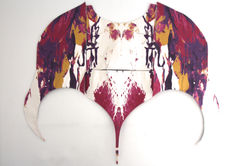EMMA MACEY
ARTIST | TEACHER
MA Project Work in Progress
Rites of Passage -Transformative Garment
This project began with a visit to the Pitt Rivers Museum. It was evident that the objects on display 'helped people deal with loss and change' (Miller, The Comfort of Things, Appendix) and that imbued them with a sense of mystery and power. These objects were integral in initiation ceremonies, funeral rites and religious services; they had a transformative power. I was keen to construct an object that both transformed physically and assisted the wearer in a psychological transformation.
It was important that the garment articulated that initiation ceremonies were not about an individual, but involved a community; ‘the success of the ritual depends on the purpose of the individuals involved within it’ (Some, 1998, p.23). For the rite of passage to be effective, a parent has to 'let go' of their child so that the child feels permitted and empowered to move forward into their adult lives. This garment represents my parental rite of passage. I want it to have an agency which simply means that it will be an active participant in shaping my actions (Schiffer, 2015). When the participants in the ritual wear it, I want it to make them move in an affected manner. (Click here for further notes on Object Agency)
The initial form is based on the form of a manta ray. This form is divided into four sections that can be used in different combinations by different wearers. The manta ray form can be wrapped around mother and infant child like a protective shroud; it can be worn by an adolescent and it can also be worn by the mother (as pictured below). I imagine that the garment would be used in all these ways during an rite of passage ceremony.





 Sketchbook ISketches of objects in the Pitt Rivers Collection. I was particularly interested in the cabinet of objects used for magic as they clearly had a very strong and almost mythic power. |  Sketchbook IISketches from the Pitt Rivers Museum Collection |  Sketchbook IIIThere was a wonderful variety of textures and materials used in the head dresses in the Pitt Rivers collection. I looked at the artefacts and then began designing my own head dresses. It was an exercise in intuitive, automatic drawing rather than a carefully considered, derivative activity. |
|---|---|---|
 Paper pattern for manta ray form |  Paper pattern for female garment |  Paper pattern for female garment |
 Paper pattern for female garment |  Paper pattern for adolescent garment |  Paper pattern for adolescent garment |
 Paper pattern for adolescent garment |  Paper pattern for female garmentI discarded this pattern (a clutch bag) in favour of using this section as a shoulder piece in the female garment. |  My youngest son Max made a series of paintings that I scanned, transformed into vector images and then digitally printed onto fabric. |
 Digital Fabric Pattern I |  Digital Fabric Pattern IIA digital fabric pattern taken from an image in the concertina sketchbook I used as part of the Desert Form Series. |  I traced the pattern onto the fabric and then cut it into the 4-sectioned manta ray shape. |
 Each section had four layers of fabric: the digitally-printed fabric, interfacing so that the plane had a starched quality capable of articulating the structured paper form, webbing to adhere the layers together and jersey so the fabric against the skin was soft and wearable. |  |  The manta ray shroud |
 The adolescent garmentI had to alter the form of the adolescent garment as the fabric did not behave in the same manner as the paper. In addition, the original pattern exposed a lot of the reverse side of the fabric; when I pinned the planned shape on the mannequin, I found that the quantity of exposed magenta unbalanced the form and so I adjusted the design to ensure much of the magenta remained hidden. |  The female garmentFor this form to work, the wings of the manta ray had to fold in half to reveal the magenta underside of the initial form. To ensure a clean fold, I sewed pockets half way down the winged sections that held structural dressmakers boning. I used polyester boning rather than wire as it was flexible and didn't disrupt the shape of the other garments. |